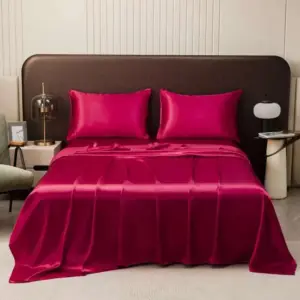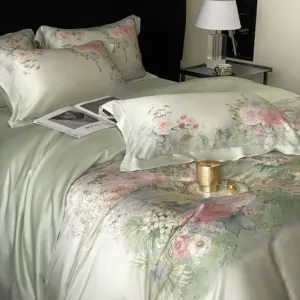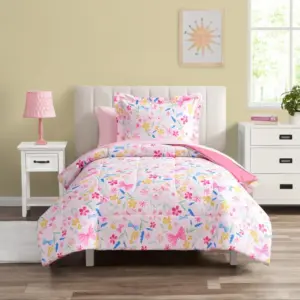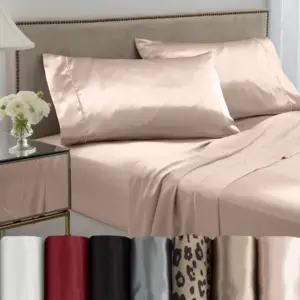Understanding the Shift Toward Sustainable Silk
The luxury textile market is experiencing a remarkable transformation as consumers increasingly prioritize sustainability alongside quality. This growing awareness has sparked a significant rise in demand for environmentally friendly silk fabrics, with the sustainable textile industry growing at an impressive 11% annually in recent years.
Today’s conscious consumers are looking beyond the surface beauty of silk to understand its broader impact. According to recent market research, over 65% of luxury textile buyers now consider environmental and ethical factors when making purchasing decisions—a dramatic increase from just a decade ago.
This shift reflects a deeper understanding of traditional silk’s hidden costs. While silk has been treasured for centuries for its incomparable feel and luster, conventional production methods raise important questions about resource usage, chemical treatments, and animal welfare.
The journey toward truly sustainable silk begins with education. By understanding the various options available, you can make choices that align with both your values and desire for quality. The amazing benefits of mulberry silk sheets remain available even when choosing more sustainable options, allowing you to enjoy luxury without compromise.
Before exploring alternatives, it’s important to establish a foundation of knowledge about quality silk materials. Understanding the complete guide to mulberry silk bed sheets provides context for appreciating how sustainable innovations maintain or enhance these cherished qualities while reducing environmental impact.
Environmental Impact of Conventional Silk Production
Traditional silk production, while yielding a luxurious product, creates a significant environmental footprint that often goes unnoticed by consumers.
Water and Energy Intensity
Conventional sericulture demands extraordinary water resources—approximately 10,000 gallons (37,850 liters) of water to produce just one pound (0.45 kg) of silk. This intensive water usage occurs throughout the production chain, from irrigating mulberry trees to the multiple washing and rinsing cycles during processing.
The energy requirements are similarly substantial, with heated water needed for cocoon softening, reeling, and degumming, plus the electricity for operating spinning and weaving equipment.
Agricultural Impact
Mulberry cultivation, essential for feeding silkworms, often relies on conventional farming practices involving synthetic pesticides and fertilizers. These chemicals can contaminate soil and water systems, affecting biodiversity in surrounding ecosystems. Dedicated mulberry plantations may also contribute to monoculture farming, reducing overall agricultural diversity.
Chemical Processing
The transformation from cocoon to finished silk involves multiple chemical processes. Conventional degumming uses alkaline solutions to remove sericin (the natural gum binding silk fibers), while bleaching, dyeing, and finishing typically employ synthetic chemicals including heavy metals, formaldehyde derivatives, and optical brighteners that can persist in wastewater.
These chemicals present risks not only to aquatic ecosystems when improperly treated but may also leave residues in the final product that contact human skin.
Learning more about eco-friendly silk production methods reveals how innovative approaches are addressing these environmental challenges while still delivering exceptional quality.
What Makes Silk “Environmentally Friendly”?
For silk to truly qualify as environmentally friendly, it must meet several critical sustainability criteria beyond simple marketing claims.
Authentically sustainable silk addresses:
- Resource Efficiency – Significantly reduced water and energy consumption throughout the production process
- Chemical Reduction – Elimination or minimization of toxic substances in growing, processing, and finishing
- Ethical Considerations – Humane treatment of silkworms and fair labor practices
- Waste Management – Reduction of production waste and implementation of recycling practices
- Biodegradability – Ensuring the final product will decompose naturally at end of life
The sustainability evaluation must extend across the entire production chain, from mulberry cultivation to final product shipping. This holistic approach ensures that improvements in one area aren’t negated by harmful practices elsewhere.
Third-party verification plays a crucial role in substantiating sustainability claims. Without independent assessment against established standards, it becomes difficult to distinguish between genuine environmental commitments and greenwashing.
Understanding why people choose mulberry silk sheets typically includes quality considerations that need not be compromised when selecting sustainable options. The best environmentally friendly silks maintain the luxurious hand-feel, breathability, and durability that make silk so desirable while reducing their planetary impact.
Peace Silk (Ahimsa Silk): The Cruelty-Free Option
Peace silk, also known as Ahimsa silk (from the Sanskrit word for “non-violence”), represents a fundamental shift in how we harvest silk. Unlike conventional production where silkworms are killed in their cocoons by steam or boiling, peace silk allows the metamorphosis process to complete naturally.
The process begins similarly to conventional silk production, with silkworms feeding on mulberry leaves. However, instead of harvesting the intact cocoons, producers wait until the moths naturally emerge, breaking through their silken homes. Only after the moths have emerged, mated, laid eggs, and completed their lifecycle do artisans collect the empty cocoons.
This ethical approach creates some distinctive differences in the final product. Since the moth breaks the continuous silk filament when emerging, peace silk consists of shorter fibers that must be spun together rather than reeled in one continuous thread. This creates a slightly different texture—somewhat less smooth than conventional silk but with a rich, slubby character that many find equally beautiful.
Peace silk production is particularly prevalent in regions of India, where it connects to cultural traditions of non-violence. The fabric typically features more natural variations in texture and appearance, celebrating rather than hiding its unique origin story.
The compassionate approach of peace silk production aligns perfectly with other natural hypoallergenic fabrics explained in our guides, offering options for those with both ethical concerns and sensitive skin.
Organic Silk: Purity Through Chemical-Free Production
Organic silk addresses the environmental challenges of conventional production by eliminating synthetic chemicals throughout the entire process. This approach focuses on purity and natural processes from mulberry cultivation through final fabric finishing.
The foundation of organic silk begins with certified organic mulberry trees, grown without synthetic pesticides, herbicides, or fertilizers. Instead, organic farmers employ natural pest management strategies, companion planting, and compost-based fertilization to maintain healthy trees.
For silk to be legitimately labeled as organic, it must meet rigorous certification standards:
- Global Organic Textile Standard (GOTS) – The leading certification requiring at least 70% organic fibers and prohibiting toxic inputs throughout production
- Organic Content Standard (OCS) – Verifies accurate organic fiber content percentages
- Soil Association Certification – UK-based standard with strict ecological requirements
Natural dyeing represents another critical aspect of organic silk production. Rather than synthetic colorants, these processes utilize plant-based dyes derived from sources like indigo, madder root, cutch, and various berries. While natural dyes may offer a more subtle color palette, they create distinctive hues that synthetic processes cannot replicate while avoiding the toxic waste associated with conventional dyeing.
The benefits extend beyond environmental protection to human health. Organic silk’s absence of chemical residues makes it particularly suitable for those with sensitive skin or chemical sensitivities.
Discover the quality difference organic standards make in our mulberry silk bedding sets collection, where sustainability meets luxury without compromise.
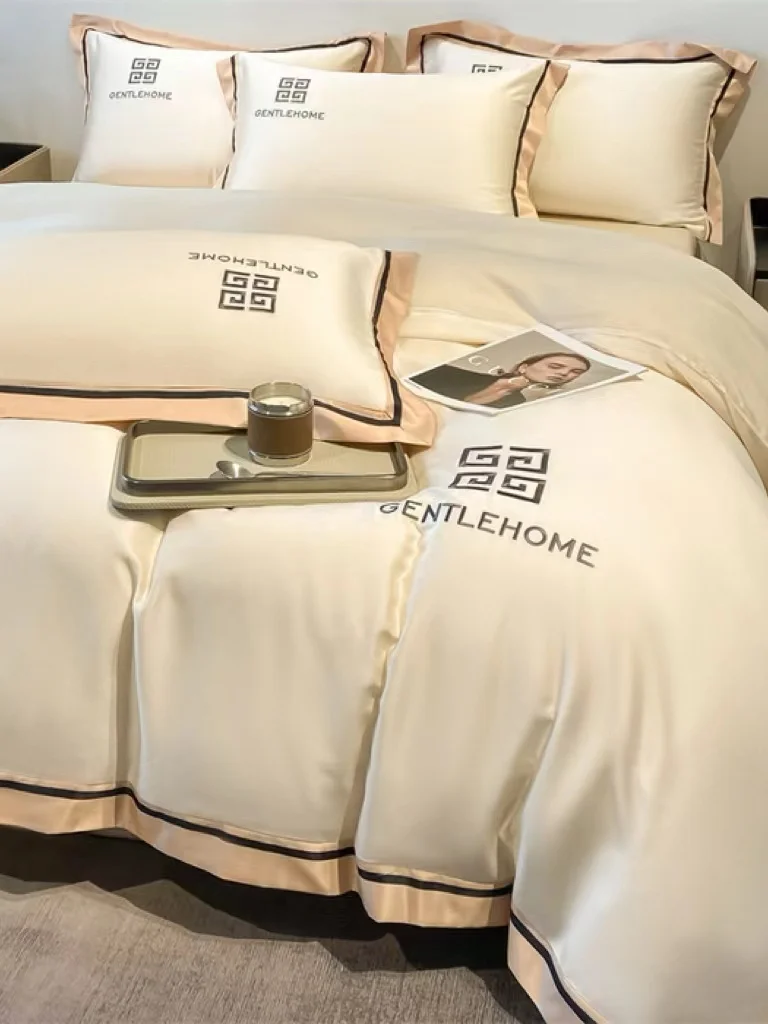
Recycled Silk: Giving New Life to Precious Fibers
Recycled silk represents an innovative approach to sustainability by reimagining existing silk materials rather than creating new ones. This process taps into the vast resources of pre-consumer and post-consumer silk waste that would otherwise end up in landfills.
The recycling process begins with careful collection of silk waste from various sources:
* Fabric scraps from garment manufacturing
* Damaged silk products from production lines
* Post-consumer silk items like clothing, scarves, and home textiles
* Silk yarn waste from weaving operations
Once collected, these materials undergo sorting by color and quality before being cleaned without harsh chemicals. The fibers are then carefully pulled apart, respun into new yarns, and woven or knitted into fresh fabrics.
The environmental benefits are substantial—recycled silk production uses approximately 90% less water and 65% less energy than creating new silk. The process also diverts textile waste from landfills, where natural fibers can take years to decompose while releasing methane, a potent greenhouse gas.
Products made from recycled silk have their own unique aesthetic appeal. The blending of fibers from various sources creates subtle color variations and textural interest that cannot be replicated in conventional production. These distinctive characteristics tell the story of the material’s previous lives.
Explore how recycled silk techniques enhance the comfort and sustainability of our silk sheets collection, where traditional luxury meets contemporary environmental consciousness.
Wild Silks: Nature’s Sustainable Treasures
Wild silks offer a fascinating alternative to cultivated silk varieties, with sustainability benefits built into their natural lifecycle. Unlike conventional silk production with its controlled environments and domesticated silkworms, wild silk comes from silkworm species that live freely in forest habitats.
These remarkable silks include:
Tussar (Tussah) Silk: Produced primarily by Antheraea mylitta moths in central and eastern India, Tussar silkworms feed on oak and juniper leaves rather than mulberry. The resulting fabric has a distinctive golden-brown color with a coarser texture that develops a beautiful sheen with age. Many Tussar silks are naturally peace silks, as cocoons are collected after the moths have emerged.
Eri Silk: Often called the “peace silk” or “non-violent silk,” Eri comes from the Samia ricini moth that feeds on castor leaves. Traditionally harvested in northeastern India and parts of Japan, Eri silk production inherently allows moths to complete their lifecycle before cocoon collection. The fabric is exceptionally soft with excellent thermal properties, making it warm in winter and cool in summer.
Muga Silk: This rare golden-hued silk is produced exclusively in Assam, India, by Antheraea assamensis moths that feed on som and soalu trees. Prized for its exceptional durability and natural metallic sheen, Muga silk can last for generations while becoming softer with each washing. Its production supports forest conservation as it depends on healthy native tree populations.
The environmental benefits of wild silk include reduced water usage, minimal chemical intervention, and support for forest biodiversity. Many wild silk harvesting communities have maintained sustainable practices for generations, creating beautiful textiles while preserving natural ecosystems.
Our luxury silk bedding sets collection includes carefully sourced wild silk products that bring this natural splendor to your home while supporting traditional artisan communities.
Plant-Based Silk Alternatives: Nature’s Innovation
For those seeking the luxurious feel of silk without any animal-derived materials, remarkable plant-based alternatives provide increasingly sophisticated options. These innovative fabrics mimic silk’s drape, sheen, and feel while offering unique sustainability stories.
| Fiber Source | Production Process | Properties | Environmental Benefits | Best Applications |
|---|---|---|---|---|
| Lotus Fiber | Hand-extracted from lotus stem threads, traditionally spun | Incredibly soft, naturally ivory-colored, breathable, lightweight | No chemicals needed, supports aquatic ecosystems, biodegradable | Luxury apparel, scarves, special occasion bedding |
| Bamboo Lyocell | Bamboo pulp processed in closed-loop lyocell system | Silky smooth, excellent drape, breathable, moisture-wicking | Fast-growing renewable resource, closed-loop processing recaptures 99% of chemicals | Bedding, intimates, lightweight clothing |
| Banana Fiber | Extracted from banana plant stems after fruit harvest | Strong yet flexible, natural sheen, slightly textured | Uses agricultural waste, biodegradable, supports farmers with secondary income | Textiles, home goods, decorative fabrics |
| Orange Fiber | Created from citrus juice byproducts | Incredibly soft, lightweight, silky feel | Repurposes food industry waste, reduces landfill burden | Luxury fashion, blended fabrics |
| Tencel™ | Wood pulp processed in closed-loop system | Extremely smooth surface, excellent drape, moisture-wicking | Sustainable forestry sources, 99% solvent recovery, biodegradable | Bedding, clothing, lingerie |
These innovative materials represent the intersection of ancient techniques and modern technology. For example, lotus fiber extraction has been practiced in Myanmar for centuries, with each fiber painstakingly hand-pulled from the stem and spun into thread. In contrast, newer innovations like Orange Fiber use advanced chemical processes to transform citrus juice byproducts into silky filaments.
The rising popularity of these alternatives reflects growing consumer interest in completely vegan luxury options that maintain the sensory experience of silk without compromise. Many of these materials offer additional benefits like enhanced breathability or moisture management that make them appealing even beyond their sustainability credentials.
Our vegan silk bedding collection features several of these revolutionary plant-based alternatives, providing the indulgent feel of silk with completely plant-derived materials.
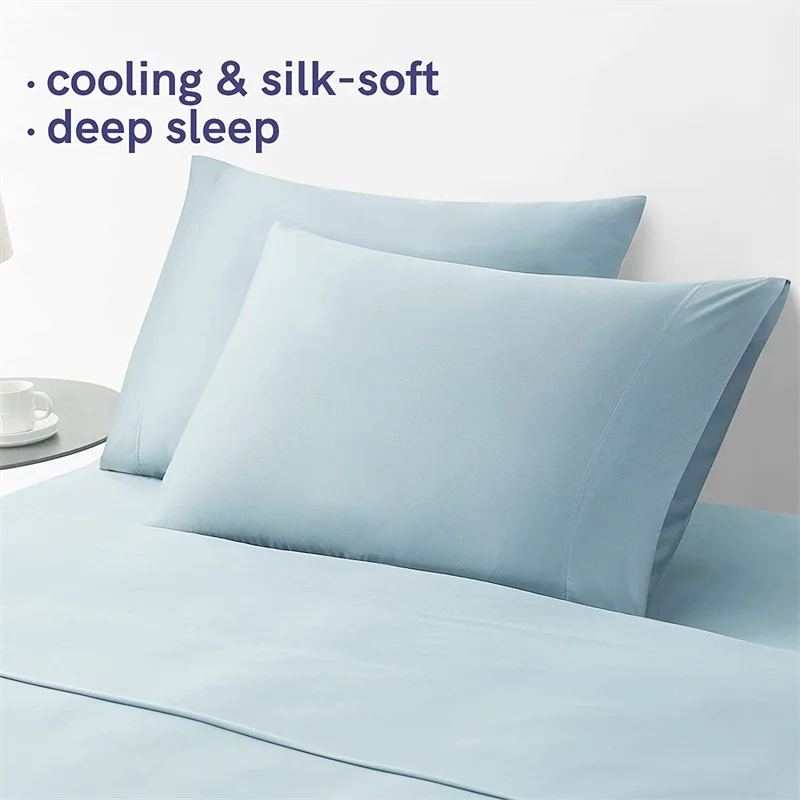
Bioengineered Silk: The Future of Sustainable Luxury
At the cutting edge of sustainable textile innovation, bioengineered silk represents a revolutionary approach that harnesses the power of modern biotechnology to create silk proteins without silkworms.
This groundbreaking process uses microorganisms—typically specially engineered yeast—programmed with silk protein DNA sequences. These microorganisms then produce pure silk proteins through fermentation, similar to how beer or yogurt is made. The proteins are purified and spun into fibers that have identical molecular structures to natural silk.
Companies like Bolt Threads have pioneered this technology with their Microsilk™ material, while other innovators continue to refine similar approaches. The environmental advantages are remarkable:
- Water usage reduced by up to 99% compared to conventional silk
- Elimination of agricultural land requirements
- No dependence on mulberry trees or silkworms
- Precisely controlled production without seasonal variations
- Zero animal involvement
While currently limited in commercial availability and relatively expensive, bioengineered silk shows tremendous promise as production scales. The technology allows for customization impossible in natural silk—scientists can enhance specific properties like strength or elasticity by modifying the protein structure.
Applications extend beyond fashion and home textiles into medical devices, where biocompatibility makes these materials excellent candidates for sutures, artificial skin, and even tissue engineering scaffolds.
For those interested in completely animal-free options, our vegan silk bedding guide provides more information about innovative alternatives including bioengineered options as they become more widely available.
Essential Certifications for Sustainable Silk
When shopping for environmentally friendly silk, certifications provide crucial verification that products meet specific sustainability standards. These third-party assessments help cut through marketing claims to identify truly responsible options.
Global Organic Textile Standard (GOTS)
* Most comprehensive textile certification covering organic fibers
* Requires minimum 70% organic fiber content
* Prohibits toxic inputs throughout production chain
* Ensures wastewater treatment at processing facilities
* Mandates social criteria including fair labor practices
OEKO-TEX® Standard 100
* Tests final products for harmful substances
* Guarantees textiles are safe for human contact
* Different certification levels based on skin contact intensity
* Does not specifically address production methods but ensures end-product safety
EU REACH Regulation
* European chemical regulation standard
* Restricts hazardous substances in products
* Requires registration and evaluation of chemicals
* Not a certification but compliance is required for EU markets
Soil Association Organic
* UK-based certification with stringent ecological standards
* Covers entire production chain from cultivation to final product
* Prohibits genetically modified organisms
* Strong focus on biodiversity protection
Peace Silk Certification
* Verifies non-violent silk harvesting methods
* Ensures silkworms complete their lifecycle
* Often combined with other sustainability certifications
* Addresses ethical rather than purely environmental concerns
When evaluating certification claims, look for specific certification numbers and verification details rather than vague statements. Legitimate certifications can be verified through certification body websites, providing confidence in the sustainability claims.
Our 100% silk sheets collection features products with appropriate certifications clearly indicated, allowing you to make informed choices with confidence in their environmental credentials.
How to Select Truly Environmentally Friendly Silk
Finding genuinely sustainable silk requires looking beyond marketing claims to evaluate products based on concrete evidence. This practical framework will help you make informed decisions:
1. Verify Certifications
Begin by checking for recognized third-party certifications discussed earlier. Look for specific certification numbers, not just logos, and be prepared to verify claims through certification websites for important purchases.
2. Assess Brand Transparency
Truly sustainable brands willingly share detailed information about their supply chain, production processes, and environmental initiatives. Look for brands that provide specific details rather than vague claims about being “eco-friendly” or “natural.”
3. Examine Material Composition
Pure silk products should clearly state the silk type (Mulberry, Peace, Eri, etc.). For blends, check the percentages of each material and research any unfamiliar components to understand their environmental impact.
4. Research Production Methods
Brands committed to sustainability will explain their processing techniques, particularly regarding water usage, dyeing methods, and chemical treatments. Look for specifics about water recycling, natural dyes, or energy reduction initiatives.
5. Consider Product Lifecycle
Evaluate durability and care requirements—a longer-lasting product that requires less frequent replacement often has a lower lifetime environmental impact. Check if the brand offers repair services or end-of-life recycling options.
Beware of greenwashing signals like vague terminology (“eco-inspired,” “earth-friendly”), unsubstantiated claims, or focus on a single environmental attribute while ignoring others. Genuine sustainability addresses multiple aspects of environmental and social responsibility.
Simple questions to ask retailers include:
* “What specific certifications does this silk product have?”
* “How and where are the silkworms raised?”
* “What dyeing process is used for these products?”
* “How does your company address water usage in silk processing?”
Our silk quality guide helps you understand the relationship between quality indicators and sustainability, ensuring you don’t sacrifice either when making your selection.
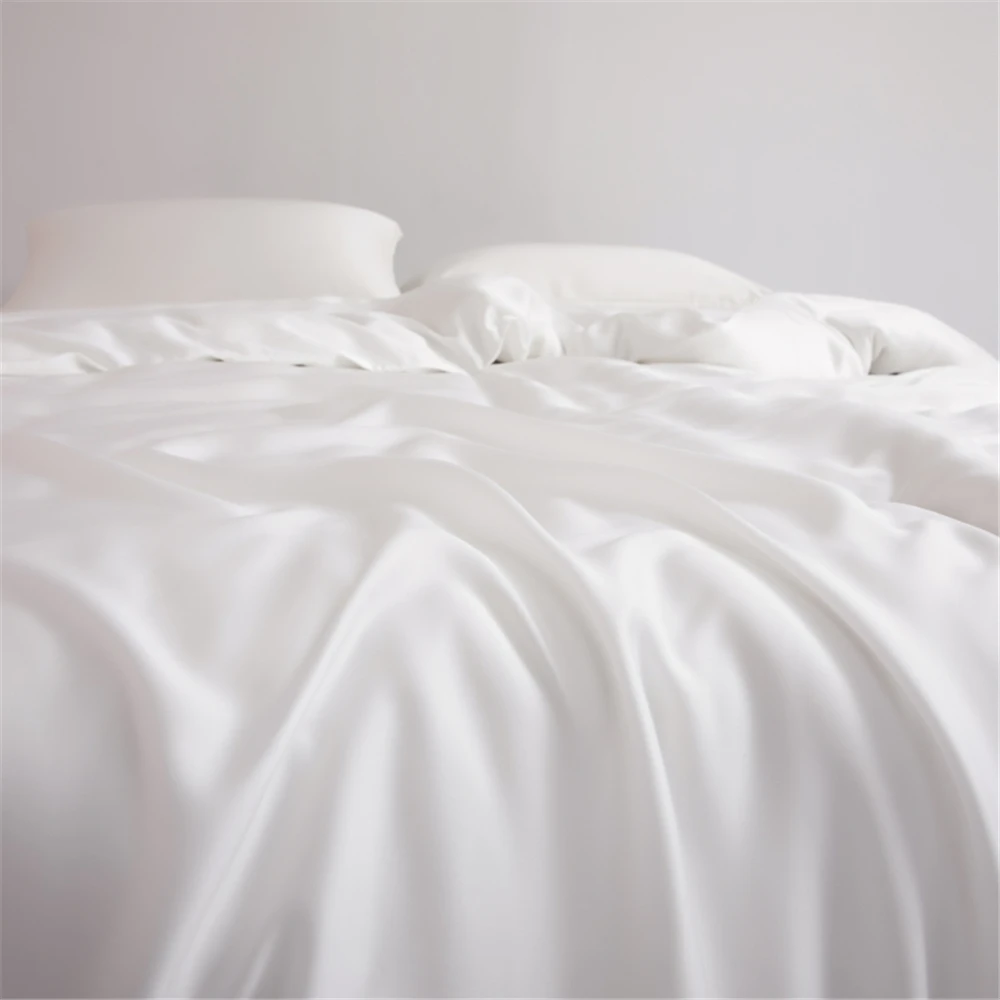
Full-size Silk Sheets, King Size Silk Sheets, Queen Size Silk Sheets, Twin Size Silk Sheets, Washable Silk Sheets
Price range: $95.95 through $178.37 Select options This product has multiple variants. The options may be chosen on the product page100% Silk Sheets, Green Silk Sheets, King Size Silk Bedding Set, Mulberry Silk Bedding Sets, Queen Size Silk Bedding Set
Price range: $1,246.21 through $1,615.22 Select options This product has multiple variants. The options may be chosen on the product pageEucalyptus Silk Bedding Sets, Eucalyptus Silk Sheets
Price range: $360.24 through $393.60 Select options This product has multiple variants. The options may be chosen on the product pagePink Silk Sheets, Twin Size Silk Sheets
$171.80 Select options This product has multiple variants. The options may be chosen on the product pageFull-size Silk Sheets, Pink Silk Sheets
$136.31 Select options This product has multiple variants. The options may be chosen on the product pageGrey Silk Sheets, Silk Sheet and Pillowcase Set
Price range: $88.20 through $146.64 Select options This product has multiple variants. The options may be chosen on the product page
Are Environmentally Friendly Silks Worth the Investment?
Many consumers hesitate when seeing the price difference between conventional and sustainable silk options. Sustainable silk products typically cost 20-40% more than their conventional counterparts, raising legitimate questions about value.
However, this price comparison alone doesn’t tell the complete story. Sustainable silk products often offer significant advantages that justify their premium:
Superior Longevity: Well-produced sustainable silks frequently last 3-5 years longer than conventional alternatives when properly cared for. This extended lifespan reduces the need for frequent replacement, creating better long-term value.
Enhanced Performance: Many eco-friendly processing methods preserve silk’s natural properties better than harsh chemical treatments. This often results in superior moisture-wicking, temperature regulation, and skin-friendliness—qualities that enhance your daily experience with the product.
Health Considerations: The absence of toxic chemical residues makes sustainable silk a healthier choice, particularly for those with sensitive skin or allergies. This benefit, while difficult to quantify monetarily, significantly impacts quality of life.
Beyond personal benefits, your investment supports the development of more sustainable production systems and sends a clear market signal about consumer priorities. Each purchase becomes a vote for the kind of textile industry we want to create.
When viewed through the lens of cost-per-use and holistic benefits rather than initial price alone, sustainable silk often represents the better value proposition despite its higher upfront cost.
Can Conventional Silk Production Ever Be Sustainable?
The sustainability of conventional silk production is evolving through incremental improvements that address its most significant environmental impacts.
Modern sericulture operations are implementing water recycling systems that can reduce freshwater consumption by up to 85% compared to traditional methods. Advanced temperature control systems in rearing houses have similarly cut energy usage by optimizing heating and cooling efficiency.
Chemical reduction initiatives show promise in conventional production. Some processors now use enzyme-based degumming instead of alkaline solutions, reducing both water pollution and energy needs. Similarly, innovations in low-impact dyeing processes that require fewer chemicals and water are gradually being adopted by mainstream producers.
However, the fundamental ethical question of silkworm treatment remains largely unaddressed in conventional production. The process still requires sacrificing silkworms before they complete their lifecycle, a practice that cannot be reconciled with certain ethical perspectives.
The most promising approach may be hybrid models that adopt sustainable innovations while maintaining the efficiency of established production systems. These balanced approaches can make meaningful environmental improvements while keeping silk accessible to wider markets.
Our mulberry silk sheets include options that incorporate these incremental improvements in conventional production, offering a middle path for consumers seeking better practices without the premium of fully sustainable alternatives.
How to Care for Your Sustainable Silk to Extend Its Lifecycle
Proper care dramatically extends the lifespan of sustainable silk products, enhancing their environmental value through reduced replacement frequency. These simple practices preserve both the beauty and performance of your eco-friendly silks:
Gentle Cleaning
* Hand wash in cool water (85°F/30°C or cooler) with pH-neutral soap specifically formulated for silk
* Avoid conventional detergents, bleach, and fabric softeners
* Never wring or twist—press water out gently between towels
* For machine-washable silk, use a mesh bag and delicate cycle
Natural Stain Treatment
* Address stains immediately with cool water
* For protein stains (food, sweat), use diluted lemon juice or vinegar
* For oil-based stains, apply cornstarch to absorb, then brush away
* Always test treatments on an inconspicuous area first
Proper Drying
* Air dry away from direct sunlight and heat sources
* Lay flat on a clean towel rather than hanging to prevent stretching
* Never use a tumble dryer, even on low heat settings
Storage Solutions
* Store clean silk in breathable fabric bags, never plastic
* Avoid cedar closets as acids can damage silk fibers
* Keep away from direct sunlight to prevent fading
* Use padded hangers for silk garments to prevent shoulder stretching
Mindful Use
* Rotate silk bedding to distribute wear evenly
* Remove jewelry before handling silk to prevent snags
* Treat minor snags immediately before they develop into runs
When repairs become necessary, seek professional services familiar with sustainable silk. Small investments in proper repair extend product life significantly and honor the resources invested in creating these special textiles.
By incorporating these care practices, your sustainable silk becomes an even more environmentally responsible choice, with years of beauty and performance ahead.


